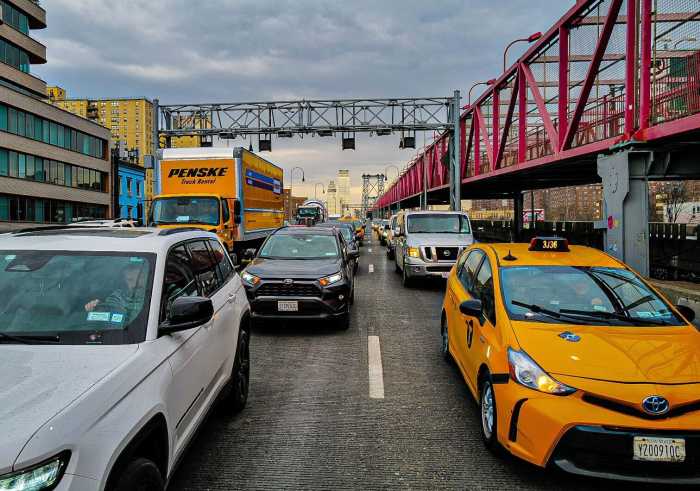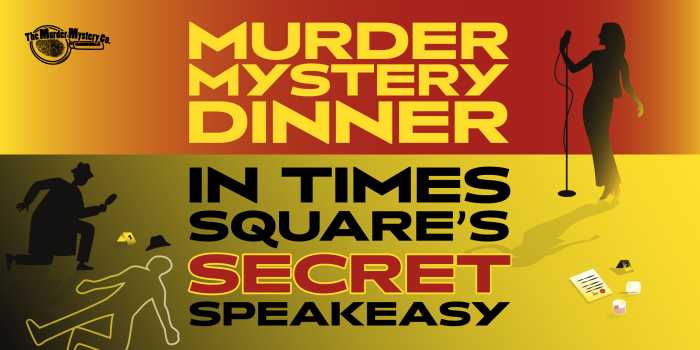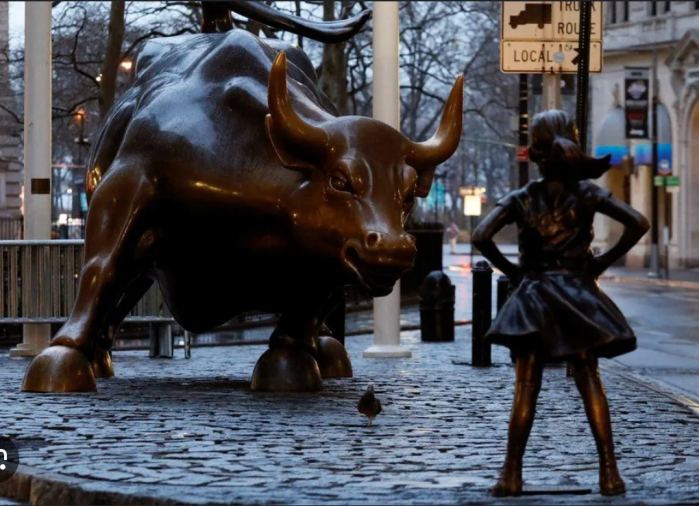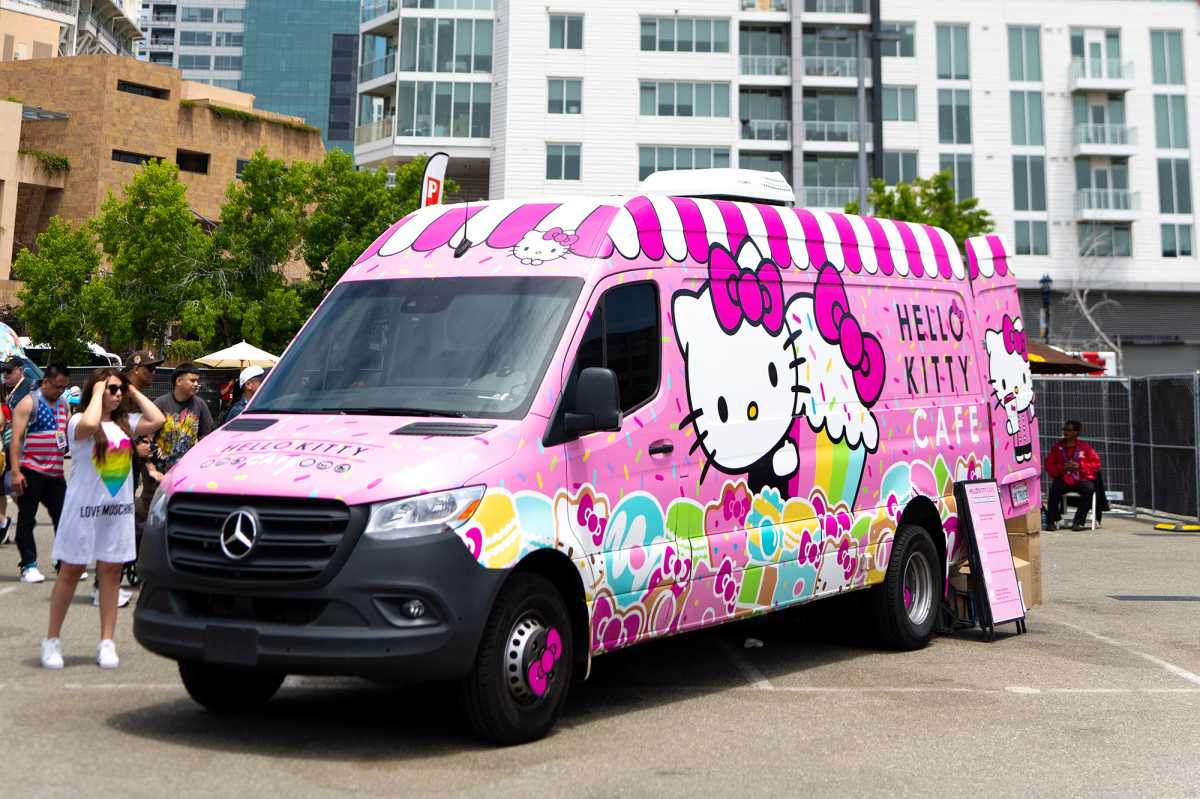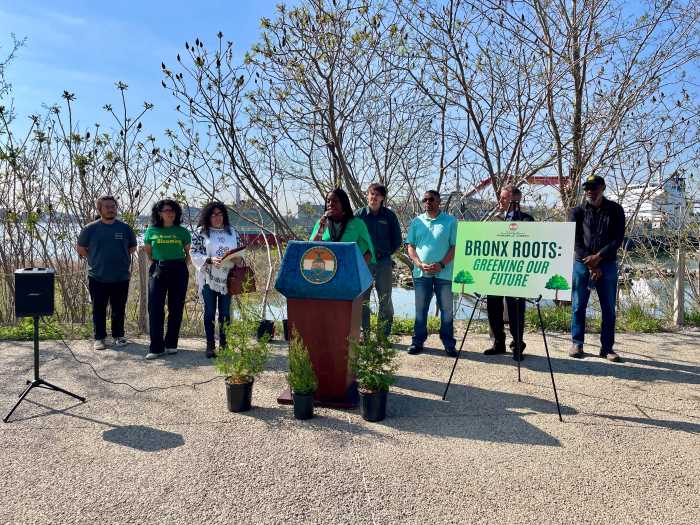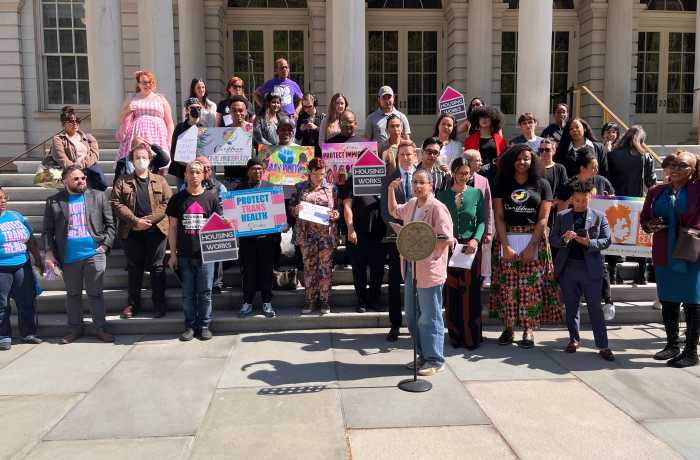
Tom Otterness designed the sculptural slide that (literally) sits in a park between W. 42 St.’s Silver Towers buildings.
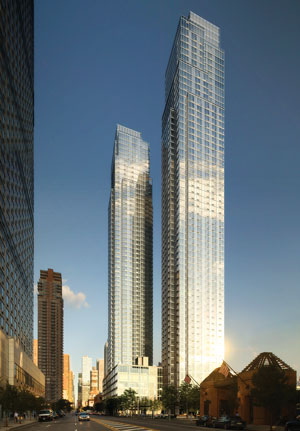
A small town, within the big city: A view of Silver Towers, looking east on W. 42nd St.
BY EILEEN STUKANE | With some reaching higher than 60 stories, the new residential towers of Hell’s Kitchen are like their own small towns within the big city.
What was once a landmarked, low-rise, walk-up neighborhood contained by a border of auto dealers, gas stations, parking lots and manufacturers is now a place that thousands of people call home. The western outskirt of Hell’s Kitchen is quickly becoming associated with luxury glass and steel structures that offer rentals, from studios to three-bedroom apartments — and that’s just the beginning.
The amenities of a high-rise such as the 60-story Silver Towers or the 63-story MiMA (Middle of Manhattan) Tower usually include a fitness center, a spa, a pool, concierge and shuttle services, indoor courtyard parks, restaurants, markets and even theaters, such as the three theaters of Signature Theatre Company in the MiMA. They are redefining what life in Hell’s Kitchen is like.
From 34th to 59th Streets, along 10th and 11th Avenues, about 20 fairly new residential high-rise buildings can be counted — with about a dozen more developments in the offering. Apartments are quickly occupied. In 2005, Hudson Yards and West Clinton were rezoned, which allowed for commercial and residential use in what was, until then, a business and manufacturing area. An added impetus came when, due to the 26 acre Hudson Yards Project (from West 30th to 33rd Streets/10th to 12th Avenues), the Metropolitan Transit Authority (MTA) decided to extend the Number 7 subway from Times Square to 11th Avenue and West 34th Street. The MTA’s station between 10th and 11th Avenues will have an escalator that brings passengers out into a newly created park, called Hudson Park & Boulevard, from West 33rd to 36th Streets.
Developers interested in the rezoned area also made commitments to reserve at least 20 percent of available units for affordable housing in exchange for the ability to create taller buildings. That 80/20 commitment has now been reworded to be a permanent 20 percent commitment. Joe Restuccia, executive director of Clinton Housing and long-time member of Community Board 4n (CB4), explains, “We have a huge affordable housing crisis in this city, but the concentration here in our neighborhood is a direct result of rezonings and the agreements that were reached between our council member and the administration over affordable housing. Those agreements are truly shaping what’s happening.”
In existence for 40 years, Clinton Housing focuses on the renovation of four- to six-story buildings (mostly walkups) for affordable housing in Hell’s Kitchen. It has developed about 1200 units in about 100 buildings, and it owns and manages 75 buildings with about 750 apartments. Lately multiple dwellings are being combined into one structure with a common lobby and elevator. Clinton Housing also works with some of the new developers to help them go through the public process in relation to affordable housing. Restuccia commends the hands-on involvement of CB4 in specifying and monitoring the needs of the community when it comes to new development.
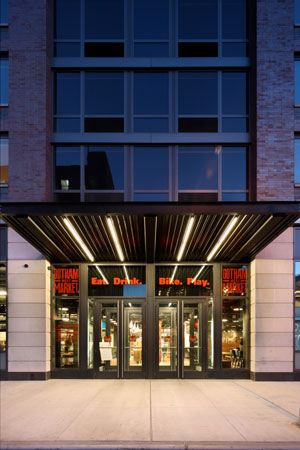
Serving the Gotham West residential tower, and attracting plenty of others, Gotham West Market’s street-level day-and-night food hall opened on Nov. 20.
Michael Samuelian, vice president of Related Companies, which is developing Hudson Yards, believes that the Yards will bridge a gap between Chelsea and Hell’s Kitchen, linking the communities in a way they’ve never been before. “We’re integrated into the street grid and the High Line. We’re in the heart of the neighborhood and we’re very sensitive to that, and want to be perceived as part of the neighborhood,” he says. Residential towers, with rentals and condos, a 12-screen movie theater, a shopping center, the arts of the planned Culture Shed and public open spaces are planned.
The first building under way at Hudson Yards, formerly the “South Tower,” renamed 10 Hudson Yards, will be 52 stories, 895 feet tall and home to Coach and L’Oreal. Not yet under construction, the tallest of the planned Hudson Yards buildings, formerly the “North Tower,” now 30 Hudson Yards on the corner of West 33rd and 10th Avenue, will be a glassy 80-story skyscraper with an observation deck — which, once completed, will be the fourth tallest building in New York (about as tall as the Empire State Building).
There are many towering glass-and-steel architectural innovations in, and coming to, Hell’s Kitchen. But there are also efforts to uphold tradition. At Gotham West, where 1,250 apartments fill a 32-story tower and three smaller buildings on a site between West 44th and 45th Streets, 10th and 11th Avenues, Chris Jaskiewicz, COO of Gotham Organization, explains that “We spent a lot of time and money designing our building to fit into the area. We used brick and different colors of brick because we wanted to respect the area.” Within the brick is a 9,000 square foot landscaped interior courtyard with a reflecting pool, which has overlook areas called “The Perch” and the “Sky Terrace.” Gotham West Market, a 10,000 square foot street-level day-and-night food hall in the building, opened on November 20th with eight establishments for food and drink. In keeping with a sense of history, “We looked at Washington Market, which was in Manhattan from 1812 until the 1960s,” says Jaskiewicz, “and that’s why we have the wire mesh canopies, the blackened steel storefronts, the polished concrete floors — because that’s how it looked.” The Gotham West Market is a handy destination when coming from Hudson River Park or a visit to the Intrepid.
Griffin Court, Alchemy Properties’ pair of eight-story buildings containing 95 condo units (on West 54th Street and 10th Avenue), is more in scale with the Hell’s Kitchen neighborhood. The developer made an effort to be part of the community by selecting a Brooklyn artist to create a tree-filled mural on two exterior walls that would extend the feel of the building’s courtyard. “To be part of the community we tried to give something back with our mural, a piece of artwork,” says Jill Preschel, sales and marketing manager of Alchemy.
Other ways the West Side of Hell’s Kitchen is getting spruced up is through its car showrooms. The dealerships on 11th Avenue have upgraded to fit into the new building boom. Mercedes-Benz, BMW, Audi and Volkswagon have shiny new showrooms marked by architectural creativity.
Restuccia notes that the changes in the community can be seen in the number of people who are passing through and staying in the newly developed hotels. The residential buildings may market themselves as having everything one could need in one location, but they are bringing in residents who become part of the community. Residents, in turn, can be overwhelmed by many transient visitors who are drawn by a proliferation of hotels. “There is a hotel that has just been announced for the southeast of West 35th and 10th Avenue. That’s a 17-story hotel opposite five-story tenements. On the corner of West 34th and 10th, a 29-story hotel will be constructed. On lower Ninth Avenue there are budget hotels that have taken up small garages,” he says. “In our neighborhood, it’s not going to be the higher end residential that brings the big change; it’s going to be the more commercial ventures that draw a different kind of crowd.”

The MiMA Tower, at 460 W. 42nd St., houses more than new Hell’s Kitchen residents. It’s also home to Signature Theatre Company’s three performance spaces.
Bonnie Brower, a resident of Hell’s Kitchen and a housing activist who worked for tenants’ rights in the 1980s, says that when it comes to the scale of new buildings and the neighborhood changes, “It’s almost like we’re a banana republic being colonized.” And a resident of Manhattan Plaza bemoans the sight of naked and underweared residents in uncurtained windows of a glossy skyscraper, when the Hudson River and Statue of Liberty used to be the view. Yet young professionals in the amenity-filled high-rise buildings feel completely at home and happy. Just as Greenwich Village was once the hot location, and then Chelsea, Hell’s Kitchen will probably settle into its new identity over the course of time. Meanwhile, construction continues.




